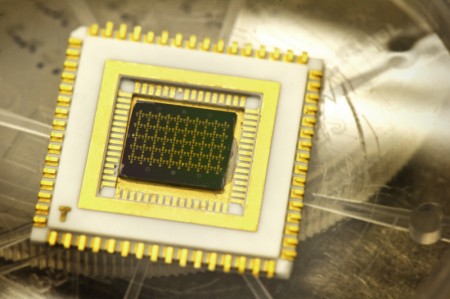Sep
11
Breakthrough Tech Cools Electrons Without Outside Energy
September 11, 2014 | 2 Comments
A team of researchers at the University of Texas at Arlington has discovered a way to cool electrons to -228 °C without external means and at room temperature. This can be an impressive advancement that may enable electronic devices to function with very little energy.

Quantum Cooled Electron Lab Test IC. The chip contains nanoscale structures that enable electron cooling at room temperature. Image Credit: University of Texas at Arlington. Click image for the largest view.
In the image above is a chip that contains nanoscale structures that enable electron cooling at room temperature. The process involves passing electrons through a quantum well to cool them and keep them from heating.
The Texas team explained its research in “Energy-Filtered Cold Electron Transport at Room Temperature” published in Nature Communications. Co-authors of the paper are Pradeep Bhadrachalam, Ramkumar Subramanian, Vishva Ray and Liang-Chieh Ma from UT Arlington, and Weichao Wang, Prof. Jiyoung Kim and Prof. Kyeongjae Cho from UT Dallas.
Research team leader Seong Jin Koh, an associate professor at UT Arlington in the Materials Science & Engineering Department said, “We are the first to effectively cool electrons at room temperature. Researchers have done electron cooling before, but only when the entire device is immersed into an extremely cold cooling bath. Obtaining cold electrons at room temperature has enormous technical benefits. For example, the requirement of using liquid helium or liquid nitrogen for cooling electrons in various electron systems can be lifted.”
Koh explained electrons are thermally excited even at room temperature, which is a natural phenomenon. If that electron excitation could be suppressed, then the temperature of those electrons could be effectively lowered without external cooling.
The team used a nanoscale structure – which consists of a sequential array of a source electrode, a quantum well, a tunneling barrier, a quantum dot, another tunneling barrier, and a drain electrode – to suppress electron excitation and to make electrons cold.
Cold electrons promise a new type of transistor that can operate at extremely low-energy consumption.
“Implementing our findings to fabricating energy-efficient transistors is currently under way,” Koh added.
Khosrow Behbehani, dean of the University of Texas Arlington College of Engineering, said this research is representative of the University’s role in fostering innovations that benefit the society, such as creating energy-efficient green technologies for current and future generations.
“Dr. Koh and his research team are developing real-world solutions to a critical global challenge of utilizing the energy efficiently and developing energy-efficient electronic technology that will benefit us all every day,” Behbehani said. “We applaud Dr. Koh for the results of this research and look forward to future innovations he will lead.”
Usha Varshney, program director in the National Science Foundation’s Directorate for Engineering, which funded the research, said the research findings could be vast. “When implemented in transistors, these research findings could potentially reduce energy consumption of electronic devices by more than 10 times compared to the present technology. Personal electronic devices such as smart phones, iPads, etc., can last much longer before recharging,” he said.
In addition to potential commercial applications, there are many military uses for the technology. Batteries weigh a lot, and less power consumption means reducing the battery weight of electronic equipment that soldiers are carrying, which will enhance their combat capability. Other potential military applications include electronics for remote sensors, unmanned aerial vehicles and high-capacity computing in remote operations.
Future research could include identifying key elements that will allow electrons to be cooled even further. The most important challenge of this future research is to keep the electron from gaining energy as it travels across device components. This would require research into how energy-gaining pathways could be effectively blocked.
This new technology has only just begun. The possible application are astounding, add LEDs as a large market and as a practical matter for now most any IC chip may benefit from cooler operation. One other point not yet mentioned is the effect the new tech could have on superconductivity efforts.
Its a major breakthrough, indeed.
Comments
2 Comments so far


So many questions and no way to answer them, I am looking forward to seeing how this can effect already existing technologies as well as future innovation. I can’t help repeating this is a major breakthrough.
If you read the abstract of the paper in Nature, you can see that this has nothing do do with making the temperature of the chip lower. It just uses a structure which only allows low energy electrons to pass through, so that after that “energy filter”, you only have low temperature electrons. You can then use these in your electronics. The actual temperature of the chip as a whole is not lower, you are just using only the portion of the electrons which happen to be low energy. This gets rid of the need to run the whole chip at low temperature to to exploit low temperature effects for electronic devices, but is useless for bulk cooling purposes.